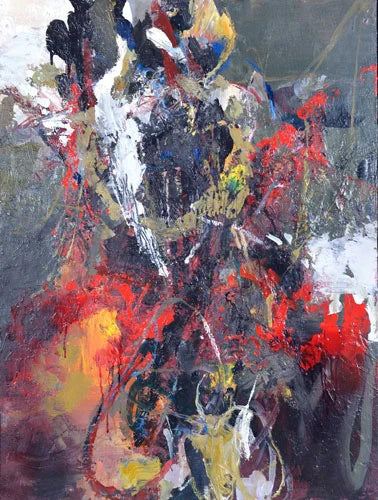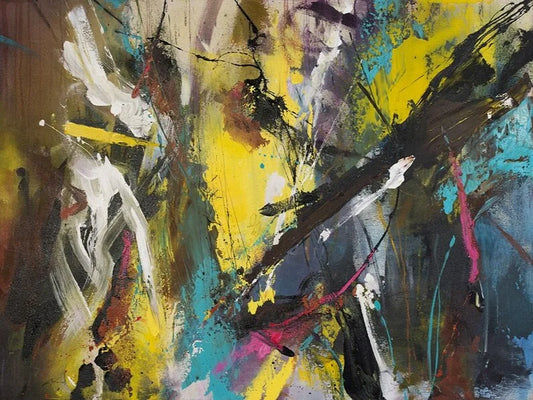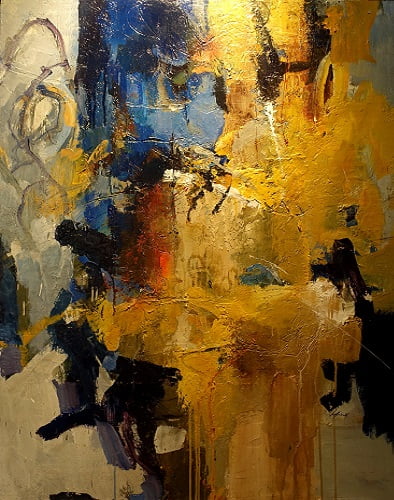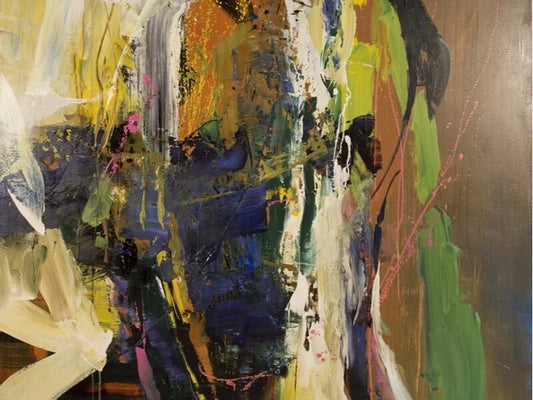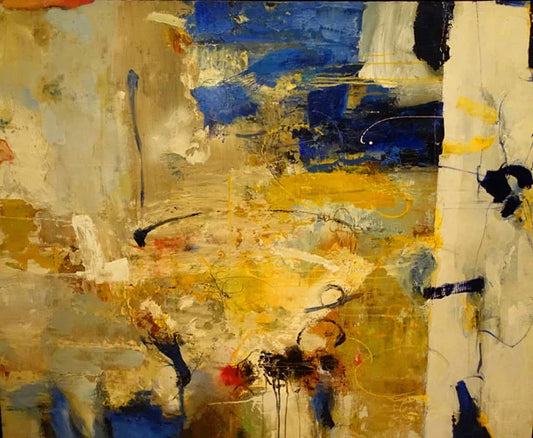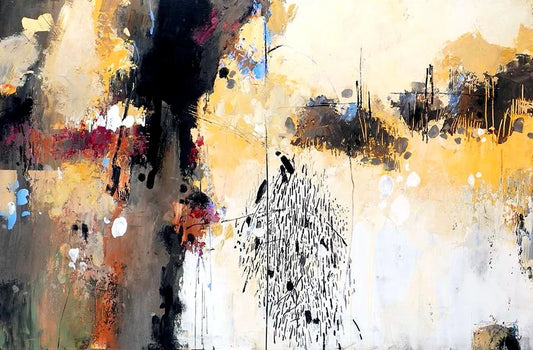Collection: Lafrance, Jean-Pierre
-
Jean-Pierre Lafrance - Difraction / Mixed Technique/Canvas, 24x48 in // 60.96x121.92 cm
Vendor:Galerie NuancesRegular price $0.00Regular price -
Jean-Pierre Lafrance - Things Are Going II / Mixed Media/Canvas, 40x30 in // 101.60x76.20 cm
Vendor:Galerie NuancesRegular price $0.00Regular price -
Jean-Pierre Lafrance - Abstract-#7-125 / Mixed Media/Canvas, 36x48 in // 91.44x121.92 cm
Vendor:Galerie NuancesRegular price $0.00Regular price -
Jean-Pierre Lafrance - Toudra / Mixed Media/Panel, 48x36 in // 121.92x91.44 cm
Vendor:Galerie NuancesRegular price $0.00Regular price -
Jean-Pierre Lafrance - Face or Profile / Mixed Media/Canvas, 48x48 in // 121.92x121.92 cm
Vendor:Galerie NuancesRegular price $0.00Regular price -
Jean-Pierre Lafrance - Eau #05-37 / Mixed Media/Panel, 48x60 in // 121.92x152.40 cm
Vendor:Galerie NuancesRegular price $0.00Regular price -
Jean-Pierre Lafrance - Episode III / Mixed Media/Panel, 48x72 in // 122x183 cm
Vendor:Galerie NuancesRegular price $0.00Regular price -
Jean-Pierre Lafrance - Live and Let Live / Mixed Media/Canvas, 72x60 in // 182.88x152.40 cm
Vendor:Galerie NuancesRegular price $0.00Regular price
Request for information
Jean-Pierre Lafrance, a great Canadian painter
A great Canadian master, painter Jean-Pierre Lafrance was born in Montreal in 1943. From the age of sixteen, he studied drawing and painting at the École des beaux-arts de Montréal. He continued his studies at Studio Salette in Montreal, then worked in the studios of sculptor and muralist Jordi Bonet, then at Atelier de l'île in Val-David, Quebec, where he mastered the many techniques of lithography and screen printing. His painting translates the body's connection to the universe, in situational and temporal terms.
An abstract art
"I never decide in advance what my paintings will look like. I work spontaneously and the result is therefore the consequence of my state of mind at the time. An unexpected gesture, a drop of paint that flows and the whole work finds a new meaning." He summarizes his painting thus: "My painting is considered abstract and, in a way, it is too, but I know that it is not really, I always start from something, from a theme which, even if it is most often vague, gives me the initial impulse of the line, of the departure but along the way, it also often happens that things are transformed." Jean-Pierre Lafrance
"After a career in fashion design and advertising illustration, Jean-Pierre Lafrance began to establish himself in the world of visual arts in the late 1980s. And his painting has virtually no kinship with his previous professions, except for one thing in common: the body. Until the late 1990s, it is apparent, although strongly interpreted and plastically treated by a fragmented material. The recognizable form remains intimate and without details. Shadows, souls... Then non-figuration takes over. Does the body disappear? Not really. It hides, it shows itself from the inside. This artist needs to feel, to make contact with everything around him. His work sessions seek a trance and, once established, his formidable and incredible intuition does the rest of the work by establishing correspondences with the greater whole..." Robert Bernier
A Quebec painter, Jean-Pierre Lafrance has participated in numerous exhibitions over the years in Canada and abroad, notably in the United States, Mexico, and France. Several articles have been published about him in various newspapers and magazines.
ADDITIONAL ARTICLE(S):
Jean-Pierre Lafrance (1943)
“A particularly interesting aspect of Jean-Pierre Lafrance’s artistic career is the speed at which he transforms his approach to the canvas. The periods follow one another rapidly, and over the past fifteen years, his visual language has undergone a considerable transformation. The most extraordinary thing is that, despite these multiple phases, he marks the medium with the same spirit, pursuing the same quest. The most striking transformation he has made is undoubtedly his shift from suggestive figuration to non-figuration.
In the early 1990s, he began designing electrical panels, in the literal sense of the term. He mixed concrete with acrylic pigment, painted his painting, and then inserted it into a box that contained a light source. Depending on whether the light was on or off, the painting manifested itself in two different states, offering a duplicate of itself. Lafrance abandoned the project and returned to it in 1999, when he was commissioned to create a work for a major artistic event, Passart, to be held the following summer in Abitibi. For the artist, the box is a metaphor for the body, the ultimate envelope through which all of our contact with the outside world is accomplished.
Generally speaking, Jean-Pierre Lafrance's work has an important spiritual dimension, even if it is not brought to the forefront. His epidermal painting translates the body's tenuous connection with the universe; the one that surrounds it and the one hidden within each individual. His painting is introspective. It expresses itself in a compulsive manner and manifests an ever-increasing distance from reality. This distance becomes beneficial on a pictorial level, because it allows the artist—although it may seem paradoxical—a more intimate perspective. Knowing how to maintain the right distance when it comes to translating what surrounds us, or rather what we experience through the prism of our experiences, is a fundamental operation, a major challenge for all high-level creators, an act of conscience, of lucidity. We can only experience reality through ourselves. All of Jean-Pierre Lafrance's work is based on his own relationship with life. Can we therefore speak of an autobiographical work? Yes, since every creative approach is deeply rooted in the self: and no, since Lafrance does not recount his life: he transposes onto the medium the codification of the intimate bond that unites him to the world. His painting is situational, in the sense that it expresses a state of being. Consequently, it carries within it a temporality, that of a present lived with such intensity that the infinite and the indefinite do not fail to merge.
Lafrance remains above all a man of intuition; he goes where he feels his own sources come from: within himself. This is why the body has dominated his work until now. It is precisely in relation to this theme that the most vital transformation of his approach took place. During the early years of his production, and until the end of the 1980s, he approached this theme from the outside, that is to say, by translating the body primarily in its visible, perceptible expressions. Today, it is the interior of the envelope that interests him. His most recent production, where many – including myself – believed they recognized an inspiration from the landscape, is eloquent in this regard. In this series, he continues the same quest for the body, which he fragments even more. This body today is one with its environment, taking shape in a bubbling of matter where the notion of volume is inscribed. The term "volume" is essential here, and it should not be confused with "perspective," because Jean-Pierre Lafrance transposes this singularity of the body and matter onto the canvas, without deconstructing it as the Cubists did. He fragments and unites the body in a molecular dance that respects the two-dimensional reality of the medium. A great plastic and aesthetic achievement, a series that never ceases to amaze us.
Source: Robert Bernier, La peinture au Québec depuis les années 1960, Les Éditions de l'Homme, 2002, Jean-Pierre Lafrance (1943), pages 187-189.
Jean-Pierre Lafrance
Identity weddings
A celebration of color
[…]Identify
Why the head? That was the starting point. For the artist, it evoked photo ID cards. The questions this raised for him quickly took the direction of a complex inner world. Just as Jean-Pierre Lafrance didn't think with words... Well, yes, of course, but not like ordinary mortals... For him, it's as if his reflections, his thoughts, passed through his feelings, his impulses as if they were filters. Inevitably, this brings him back to himself, as if somewhere inside him, he had created a space in which a multitude of states accumulated, of lived moments that intertwined with one another in an infinite number of combinations. A library of diverse emotions, more or less refined, sometimes conscious, often not, and which, in turn, contained series of sophisticated and contradictory impressions ultimately putting his cognitive and sensory senses into action. What some call experience, intimacy. For Lafrance, this takes the form of a multi-layered experience where his relationships to (and with) life are displayed. A summation. This is precisely what he expresses with great intensity and passion in each of the paintings, sculptures, drawings, or prints that leave his studio.
Jean-Pierre Lafrance is a curious being, he wants to learn, see, be surprised, always, all the time. He is always in a state of necessity and urgency. This singular state of mind allows him to face certain extreme situations with more avidity than fear, like three years ago, when he had to have heart surgery, when he had just been told that he might have to change it… He who sometimes, from his home on the banks of the Richelieu, feels the blurry river… You will understand that his connection between his body and the outside world is very tenuous. And precisely, his series on identity expresses this unique relationship between his profession, his life, his world in his reality. It expresses above all his experience, his life. As if he were closing the circle. Each of his works in this series is like a view of his inner being, and despite the suggestiveness that painting with such closeness to oneself entails, his greatest achievement is to have managed to do so with a certain objectivity, like a lucid observation of the present. From this spring forth states of being that are enjoyable, explosive, angry, and happy. As if he were inviting us to share a great feast. A feast of being. A wedding of identity... Without embellishment. Just between us and him...
Source: Robert Bernier, Revue Parcours, Parcours Art & Art de vivre, numéro 71, Novembre 2010 à février 2011, Jean-Pierre Lafrance Noces identitaires Une fête de la couleur, pages 29-33.
TO LEARN MORE:
. WIKIPEDIA - JEAN-PIERRE LAFRANCE
. VIE DES ARTS - JEAN-PIERRE LAFRANCE


